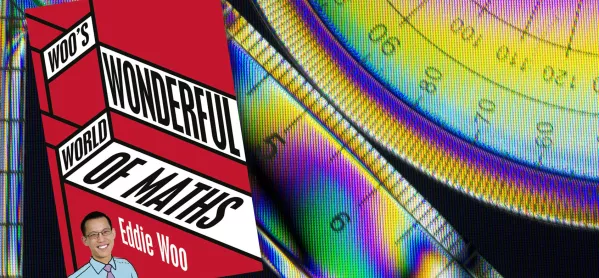- Home
- Book review: Woo’s Wonderful World of Maths
Book review: Woo’s Wonderful World of Maths

Woo’s Wonderful World of Maths
Author: Eddie Woo
Publisher: Macmillan Australia
Details: 369pp, from £30.74
ISBN: 9781760554217
I have a dream that one day when I tell someone I’m a maths teacher, I will get a beaming smile, swiftly followed by, “Ooh, I loved maths when I was at school.” My experience, however, tells me that the best I can expect is an awkward silence coupled with a pitying look as if it had been the only career option open to me.
So, when I opened Eddie Woo’s Wonderful World of Maths and started to read the prologue, I envisaged a “maths fairy” somewhere losing its wings as he wrote about his struggles with maths and barely tolerating the subject while at school.
It did get better. Much better. Eddie Woo is a man on a mission to share the secrets he discovered on his journey to understand that “maths is all around us”. This isn’t a conventional book about maths. Rather, its 26 chapters feel like a collection of mini-essays on such a variety of topics that even if one or two of them didn’t actually float my boat, it wasn’t an issue and certainly didn’t deter me. In fact, Woo’s enthusiasm for maths is obvious on every page and it’s slightly infectious. The opening chapter is titled “Born mathematicians” and aims to reassure the reader that we are all mathematicians at heart because our brains are pattern-recognising machines.
If I am honest, I wasn’t a fan of the book’s colour scheme of red, black and white (and incessant patterns) as they made a couple of the chapters difficult to read for any length of time (although, to continue being honest, that may be because I’m fighting the fact that I probably need to wear reading glasses).
Despite the style choices, Woo very methodically builds remarkable cases for the explanation of maths in the world around us, in a very entertaining way. I particularly liked the chapters concerning proof and the so-called party problem that includes a judge, jury, barristers and defendants. Spoiler: the minimum number of people needed at a party to guarantee that three people are mutual friends, or three people are mutual strangers, is 6.
There isn’t always an obvious link between each of the intriguingly titled chapters such as “Tea cups and (almost) infinite money” or “What sunflowers know about the universe”, which is why it feels more like mini-essays, but this made it a book to easily dip in and out of.
“Lightning through your veins” got my attention by comparing lightning and our blood vessels. Woo takes the scenic route through ancient Greece and explores Euclid, geometry and Greek philosophy. This was a fun journey that moves from Euclid’s flawless smooth shapes to fractal geometry and on to lightning and blood vessels.
The book is littered with references to historical figures and there is no more an iconic figure in maths than Pythagoras. In the chapter titled “Music to my ears”, we are treated to the tale of how Pythagoras was walking past a blacksmith and noticed how different anvils made different sounds when hit. According to the legend, Pythagoras then began experimenting himself by banging on metals that the blacksmith had left in the street.
There is also a suitable amount of cynicism as to the historical record because, of course, “when you’re a free-thinking Greek philosopher, no one minds if you hit their belongings for no apparent reason”. This story is used to introduce sine wave graphs to illustrate the pattern of different sounds and to explain why musical notes are shown as regular and even, whereas sounds such as footsteps or a car engine, appear uneven and chaotic.
Sine waves also make an appearance in “Why my pancreas is like a pendulum” to illustrate negative feedback systems in contexts as diverse as glucose level through to real estate values and economic markets, which Woo uses to illustrate the idea that “a single idea... may be hiding underneath things that seem completely different on the outside”.
Maybe I was lucky, but I had an amazing maths teacher, who instilled in me that maths is more than just being good at “sums”. At its most basic level, it is a body of knowledge that has developed over thousands of years that we need to pass on to the next generation for them to develop further but it is so, so, so much more: it is a language we can use to interpret the world. So, unlike Woo, I bloody loved maths when I was at school.
But having finished the book, I “got it”. I got why Woo chose to open the book in the way he did. He wants to appeal to almost everyone who isn’t a maths teacher. He wants to share how he discovered that maths is more than he thought it was. I applaud the mission he is on.
Mel Muldowney is a secondary maths teacher at a school in the West Midlands. She tweets as @Just_Maths.
You can support us by clicking the title link: we may earn a commission from Amazon on any purchase you make, at no extra cost to you
Keep reading for just £1 per month
You've reached your limit of free articles this month. Subscribe for £1 per month for three months and get:
- Unlimited access to all Tes magazine content
- Exclusive subscriber-only stories
- Award-winning email newsletters